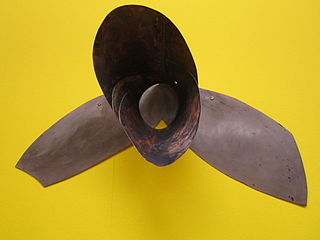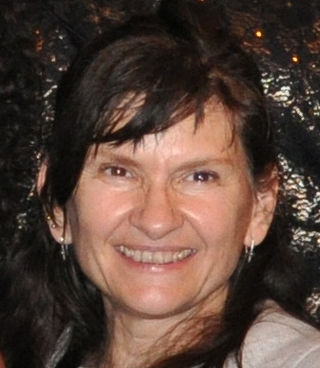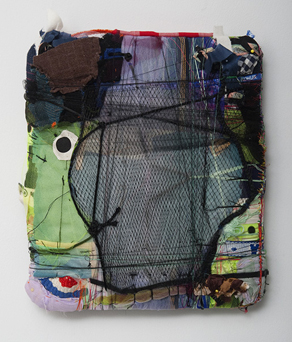Alison Saar is a Los Angeles, California based sculptor, mixed-media, and installation artist. Her artwork focuses on the African diaspora and black female identity and is influenced by African, Caribbean, and Latin American folk art and spirituality. Saar is well known for "transforming found objects to reflect themes of cultural and social identity, history, and religion." Saar credits her parents, collagist and assemblage artist Betye Saar and painter and art conservator Richard Saar, for her early exposure to are and to these metaphysical and spiritual practices. Saar followed in her parents footsteps along with her sisters, Lezley Saar and Tracye Saar-Cavanaugh who are also artists. Saar has been a practicing artist for many years, exhibiting in galleries around the world as well as installing public art works in New York City. She has received achievement awards from institutions including the New York City Art Commission as well as the Institute of Contemporary Art in Boston.

Alison Mary Wilding OBE, RA is an English artist noted for her multimedia abstract sculptures. Wilding's work has been displayed in galleries internationally.

Rhea Carmi, is an Israeli American abstract and mixed-media artist and sculptor.

Alexandra Grant is an American visual artist who examines language and written texts through painting, drawing, sculpture, video, and other media. She uses language and exchanges with writers as a source for much of that work. Grant examines the process of writing and ideas based in linguistic theory as it connects to art and creates visual images inspired by text and collaborative group installations based on that process. She is based in Los Angeles.
Lita Albuquerque is an American installation, environmental artist, painter and sculptor. She is a part of the core faculty in the Graduate Fine Art Program at Art Center College of Design.
May Sun is a Los Angeles–based artist known primarily for her public art projects. Sun works in the mediums of sculpture, mixed media, photography and installation. Her work has been exhibited nationally and internationally. She was born in Shanghai, China, moved to Hong Kong at the age of two with her family and immigrated to the United States in 1971 to attend the University of San Diego. "May Sun often refers to aspects of her Chinese heritage in her work, which consistently crosses cultural and political boundaries as well as the boundaries traditionally separating art forms and disciplines."

Maren Hassinger is an African-American artist and educator whose career spans four decades. Hassinger uses sculpture, film, dance, performance art, and public art to explore the relationship between the natural world and industrial materials. She incorporates everyday materials in her art, like wire rope, plastic bags, branches, dirt, newspaper, garbage, leaves, and cardboard boxes. Hassinger has stated that her work “focuses on elements, or even problems—social and environmental—that we all share, and in which we all have a stake…. I want it to be a humane and humanistic statement about our future together.”

George Herms is an American artist best known for creating assemblages out of discarded, often rusty, dirty or broken every-day objects, and juxtaposing those objects so as to infuse them with poetry, humor and meaning. He is also known for his works on paper, including works with ink, collage, drawing, paint and poetry. The prolific Herms has also created theater pieces, about which he has said, "I treat it as a Joseph Cornell box big enough that you can walk around in. It's just a continuation of my sculpture, one year at a time." Legendary curator Walter Hopps, who met Herms in 1956, "placed Herms on a dazzling continuum of assemblage artists that includes Pablo Picasso, Kurt Schwitters, Marcel Duchamp, and Joseph Cornell, as well as California luminaries Wallace Berman and Edward Kienholz." Often called a member of the West Coast Beat movement, Herms said that Wallace Berman taught him that "any object, even a mundane cast-off, could be of great interest if contextualized properly." "That’s my whole thing," Herms says. "I turn shit into gold. I just really want to see something I've never seen before." George Herms lives and works in Los Angeles.

Kim Victoria Abeles is an American interdisciplinary artist and professor emeritus. She was born in Richmond Heights, Missouri, and currently lives in Los Angeles. She is described as an activist artist because of her work's social and political nature. In her work, she’s able to express these issues and shine a light on them to larger audiences. She’s able to show the significance of the issues by creating a piece that involves an object and adds the struggle attached to it, which represents what is happening in current events. She is also known for her feminist works. Abeles has exhibited her works in 22 countries and has received a number of significant awards including a Guggenheim Fellowship. Aside from her work as an artist, she was a professor in public art, sculpture, and drawing at California State University, Northridge from 1998 to 2009, after which she became professor emerita in 2010.
Liz Craft is a Los Angeles installation artist and sculptor. She co-runs the Paradise Garage in Venice Beach, California. Her artwork has been exhibited internationally and collected by museums including the Los Angeles County Museum of Art, LACMA, and the Hammer Museum in Los Angeles.
Jeff Colson is an American artist.

Kim Schoenstadt is a Los Angeles based artist. She currently lives in Venice, California.
Jacci Den Hartog is an American sculptor.

Françoise Grossen is a textile artist known for her braided and knotted rope sculptures. She lives and works in New York City. Grossen’s work has been acquired by the Metropolitan Museum of Art, New York; the Renwick Gallery, Smithsonian American Art Museum, Washington, DC; and the State Hermitage Museum, Saint Petersburg, Russia.

Julia Couzens is a California-based, American artist known for a diverse body of work that embraces unconventional materials and methods and includes drawing, sculpture, installation art, and writing. Critic David Roth identifies as a connecting thread in her evolving work, her "decidedly surrealist-symbolist sensibility, in which eroticism, the grotesque and the gothic mix in equal parts." Her work has been shown internationally and throughout the United States, including solo exhibitions at the Christopher Grimes Gallery and California State University, Stanislaus (2009), in surveys at the University of California, Davis and Sonoma Museum of Visual Art (1999), and group shows at the Crocker Art Museum, P•P•O•W, Orange County Museum of Art, Hammer Museum, and BAMPFA, among others. Her art has been reviewed in the Los Angeles Times, San Francisco Chronicle, Flash Art, New Art Examiner, and Art Practical, among other publications, and collected by institutions including the Crocker Art Museum, Fine Arts Museums of San Francisco, Oakland Museum of California and Butler Institute of American Art, among many. In addition to working as an artist, Couzens has taught at several Southern California universities and writes about contemporary art for The Sacramento Bee and Squarecylinder. She lives and works on Merritt Island in the Sacramento River delta community of Clarksburg and maintains a studio in downtown Los Angeles.
Carole Ann Klonarides is an American curator, video artist, writer and art consultant that has been based in New York and Los Angeles. She has worked in curatorial positions at the Santa Monica Museum of Art (1997–2000) and Long Beach Museum of Art (1991–95), curated exhibitions and projects for PS1 and Museum of Modern Art (MOMA), Laforet Museum (Tokyo), and Video Data Bank, among others, and been a consultant at the Getty Research Institute. Klonarides emerged as an artist among the loosely defined Pictures Generation group circa 1980; her video work has been presented in numerous museum exhibitions, including "Video and Language: Video As Language", "documenta 8," "New Works for New Spaces: Into the Nineties,", and "The Pictures Generation, 1974-1984", and at institutions such as MoMA, the Smithsonian Hirshhorn Museum, Contemporary Arts Center, the New Museum, The Kitchen, and School of the Art Institute of Chicago (2016). Her work belongs to the permanent collections of MoMA, the Whitney Museum of American Art, Getty Museum, Centre Pompidou, Contemporary Arts Museum Houston, Museu-Fundacão Calouste Gulbenkian (Lisbon), Museo Nacional Centro de Arte Reina Sofía (Madrid), and National Gallery of Canada, and is distributed by the Video Data Bank and Electronic Arts Intermix (EAI).

Elyn Zimmerman is an American sculptor known for her emphasis on large scale, site specific projects and environmental art. Along with these works, Zimmerman has exhibited drawings and photographs since graduating with an MFA in painting and photography at University of California, Los Angeles in 1972. Her teachers included Robert Heineken, Robert Irwin, and Richard Diebenkorn.
Won Ju Lim is a Korean American artist. She currently divides her time between Los Angeles, CA and Boston, MA.

Lezley Irene Saar is an African American artist whose artwork is responsive to race, gender, female identity, and her ancestral history. Her works are primarily mixed media, 3-dimensional, and oil & acrylic on paper and canvas. Through her artistic practice Lezley explores western and non-western concepts of beauty, feminist psychology and spirituality. Many works conjure elements of magical realism. She has exhibited widely in the U.S. and internationally. Her work is included in museum collections such as The Kemper Museum, CAAM, The Ackland Art Museum, the Smith College Museum of Art, the Studio Museum in Harlem and MOCA. She is currently represented by Walter Maciel Gallery in Los Angeles and Various Small Fires in Asia.

Lynn Aldrich is an American sculptor whose diverse works draw on a wide range of high and low cultural influences and materials. Her work can range from what art writers describe as "slyly Minimalist meditations" on color, light and space to whimsical "Home Depot Pop" that reveals and critiques the excesses—visual, formal and material—of unbridled consumption. Critics Leah Ollman and Claudine Ise of the Los Angeles Times have described Aldrich's art, respectively, as a "consumerist spin on the assemblage tradition" and a "witty and inventive brand of kitchen-sink Conceptualism" LA Weekly critic Doug Harvey calls her "one of the most under-recognized sculptors in L.A.," whose hallmarks are the poetic transformation of found/appropriated materials, formal inventiveness and restless eclecticism. Aldrich has exhibited at the Museum of Contemporary Art, Los Angeles (MOCA), Los Angeles County Museum of Art (LACMA), Hammer Museum, Santa Monica Museum of Art, and venues throughout the United States and Europe. She has been recognized with a Guggenheim Fellowship (2014) and public art collection acquisitions by LACMA, MOCA Los Angeles and the Portland Art Museum, among others.















